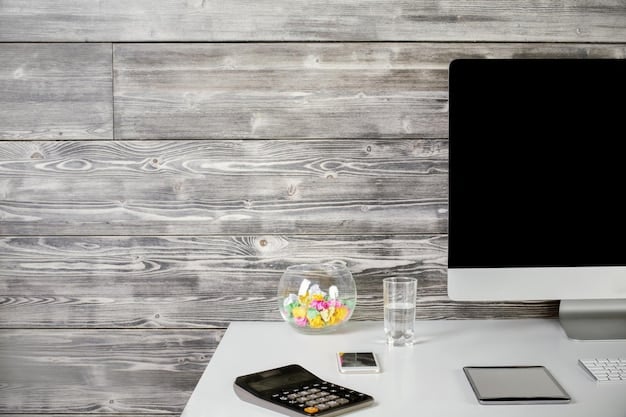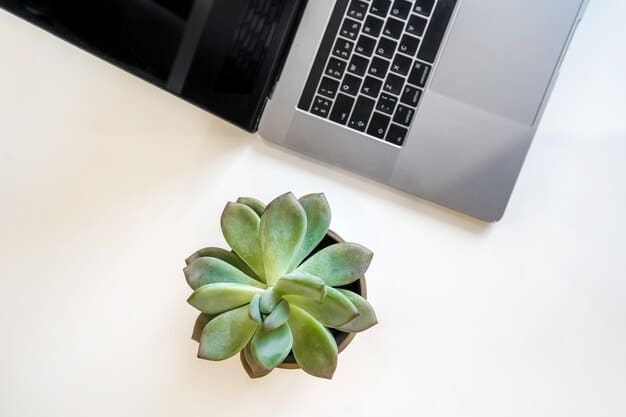Eco-Friendly Home Office: 6 Ways to Boost Productivity

Creating an eco-friendly home office not only benefits the environment but can also significantly increase productivity by promoting a healthier and more focused workspace through sustainable practices and mindful choices.
Transforming your home office into an eco-friendly home office: 6 Ways to Create a Sustainable Workspace and Boost Productivity by 10% is a win-win. You get to reduce your environmental footprint while simultaneously boosting your productivity.
Why Create an Eco-Friendly Home Office?
Creating an eco-friendly home office is about more than just being green; it’s about fostering a work environment that supports your well-being and productivity. It involves making conscious choices about the materials you use, the energy you consume, and even the air you breathe within your workspace.
By adopting sustainable practices, you’re not only reducing your environmental impact but also enhancing your focus and creativity. Let’s delve into the key reasons why an eco-friendly home office is a smart move.
Health and Well-being
Eco-friendly materials often contain fewer harmful chemicals, leading to better air quality in your office. Traditional office furniture and supplies can release volatile organic compounds (VOCs), which can cause headaches, allergies, and other health issues. Opting for natural, non-toxic alternatives can significantly improve your indoor air quality.
Additionally, incorporating plants into your workspace not only adds a touch of nature but also helps purify the air. Studies have shown that plants can reduce stress levels and increase feelings of well-being, contributing to a healthier and more pleasant work environment.
Improved Focus and Productivity
A clutter-free, organized space is essential for maintaining focus and productivity. An eco-friendly approach often involves minimalist design principles, encouraging you to streamline your workspace and eliminate unnecessary items. This can lead to a more calming and efficient environment.
Furthermore, the conscious act of making eco-friendly choices can boost your mental clarity and motivation. Knowing that you’re contributing to a more sustainable future can instill a sense of purpose and pride in your work, enhancing your overall productivity.
Cost Savings in the Long Run
While some eco-friendly products may have a higher upfront cost, they often lead to long-term savings. Energy-efficient lighting, such as LED bulbs, consumes significantly less electricity than traditional incandescent bulbs, resulting in lower energy bills. Similarly, investing in durable, sustainable furniture can save you money in the long run by reducing the need for frequent replacements.
Adopting practices like reducing paper consumption and using reusable items can also lead to substantial cost savings over time. Small changes can add up to significant financial benefits while also benefiting the environment.
- Reduce exposure to harmful chemicals.
- Enhance concentration and motivation.
- Lower energy bills and reduce waste.
In conclusion, creating an eco-friendly home office is an investment in your health, productivity, and the environment. By making informed choices about the products you use and the practices you adopt, you can create a workspace that is both sustainable and conducive to your best work.
Choosing Sustainable Furniture and Materials
The furniture and materials you choose for your home office play a crucial role in its overall environmental impact. Opting for sustainable options not only reduces your carbon footprint but also ensures a healthier and more aesthetically pleasing workspace.
From reclaimed wood to recycled fabrics, numerous eco-friendly alternatives are available to furnish your office. Let’s explore some of the best choices.
Reclaimed Wood Furniture
Reclaimed wood is sourced from old buildings, barns, and other structures, giving it a second life instead of ending up in a landfill. This type of furniture has a unique character and charm, adding a rustic yet sophisticated touch to your home office.
By choosing reclaimed wood, you’re reducing the demand for newly harvested timber, which helps preserve forests and biodiversity. Additionally, reclaimed wood often has a rich history, making each piece a conversation starter.
Recycled and Upcycled Materials
Furniture made from recycled materials, such as recycled plastic or metal, is another excellent eco-friendly option. These materials divert waste from landfills and reduce the need for virgin resources. Upcycled furniture, which transforms discarded items into functional pieces, is also a creative and sustainable choice.
For example, an old door can be repurposed into a desk, or tires can be transformed into comfortable seating. These options not only reduce waste but also add a unique and personalized touch to your office.
Eco-Friendly Fabrics and Textiles
When selecting chairs, cushions, and other fabric-covered items, opt for textiles made from sustainable materials such as organic cotton, hemp, bamboo, or recycled polyester. These fabrics are produced with minimal environmental impact, reducing the use of pesticides, water, and other resources.
Additionally, consider fabrics that are dyed with natural, non-toxic dyes to avoid harmful chemicals. Choosing eco-friendly fabrics ensures a healthier and more sustainable home office.

- Choose furniture made from reclaimed wood.
- Opt for items made from recycled or upcycled materials.
- Select fabrics made from sustainable materials like organic cotton.
In summary, selecting sustainable furniture and materials is a significant step toward creating an eco-friendly home office. By choosing reclaimed wood, recycled materials, and eco-friendly fabrics, you can reduce your environmental impact while creating a stylish and functional workspace.
Reducing Energy Consumption in Your Home Office
Energy consumption is a significant factor in the environmental impact of your home office. Reducing your energy usage not only saves money on your utility bills but also lowers your carbon footprint. There are several simple yet effective strategies to minimize energy consumption in your workspace.
From energy-efficient lighting to smart power management, let’s explore how you can create a more sustainable and energy-conscious home office.
Energy-Efficient Lighting
One of the easiest ways to reduce energy consumption is by switching to energy-efficient lighting options. LED bulbs use up to 75% less energy and last much longer than traditional incandescent bulbs. While the upfront cost may be higher, the long-term savings make them a worthwhile investment.
Additionally, make the most of natural light by positioning your desk near a window. Natural light not only reduces the need for artificial lighting but also has numerous health benefits, including improved mood and increased vitamin D production.
Smart Power Management
Many electronic devices continue to consume energy even when they’re turned off. This is known as “phantom load” or “vampire power.” To avoid this, use power strips to easily switch off multiple devices at once when they’re not in use. Also, unplug chargers when they’re not actively charging devices.
Consider using smart power strips that automatically shut off power to devices when they’re not in use. These strips can detect when a device is fully charged or turned off and cut off the power supply, saving you energy and money.
Energy-Efficient Electronics
When purchasing new electronic devices for your home office, look for Energy Star-certified products. These products meet strict energy efficiency guidelines set by the Environmental Protection Agency (EPA). Energy Star-certified computers, monitors, and printers consume less energy than standard models, helping you reduce your overall energy consumption.
Additionally, consider using a laptop instead of a desktop computer, as laptops typically consume less energy. Adjust your computer’s power settings to automatically enter sleep mode after a period of inactivity to conserve energy.
By implementing these strategies, you can significantly reduce your energy consumption and create a more sustainable home office. Energy-efficient lighting, smart power management, and energy-efficient electronics are all essential components of an eco-friendly workspace.
Embracing Paperless Practices
Reducing paper consumption is a critical aspect of creating an eco-friendly home office. Traditional offices often rely heavily on paper, leading to deforestation and increased waste. By embracing paperless practices, you can minimize your environmental impact and create a more organized and efficient workspace.
From digital note-taking to online document management, there are numerous ways to reduce your reliance on paper. Let’s explore some effective strategies.
Digital Note-Taking and Planning
Instead of using paper notebooks and planners, switch to digital alternatives such as note-taking apps and online calendars. Apps like Evernote, OneNote, and Google Keep allow you to create and organize notes digitally, eliminating the need for paper. Online calendars like Google Calendar and Outlook Calendar make it easy to schedule appointments and manage your time without using a paper planner.
Consider using a tablet with a stylus for handwritten notes and sketches. This allows you to replicate the experience of writing on paper while still maintaining a digital workflow.
Online Document Management
Transition from paper filing systems to online document management systems. Store your documents in the cloud using services like Google Drive, Dropbox, or Microsoft OneDrive. This not only reduces paper consumption but also makes it easier to access and share documents from anywhere.
Use a scanner to digitize existing paper documents and upload them to your online storage system. Implement a clear and consistent naming convention to keep your digital files organized.
Reduce Printing and Reuse Paper
Whenever possible, avoid printing documents. Review and edit documents on-screen, and only print when absolutely necessary. When printing is unavoidable, use both sides of the paper to reduce waste. Consider using recycled paper for printing to further minimize your environmental impact.

- Switch to digital note-taking and planning apps.
- Use online document management systems for storing files.
- Reduce printing and reuse paper when necessary.
By embracing paperless practices, you can significantly reduce your paper consumption and create a more sustainable home office. Digital note-taking, online document management, and mindful printing habits are all essential components of an eco-friendly workspace.
Incorporating Plants and Natural Elements
Bringing plants and natural elements into your home office is a fantastic way to create a more inviting, healthy, and productive workspace. Plants not only add a touch of beauty but also purify the air, reduce stress, and boost creativity.
From potted plants to natural light, there are several ways to incorporate nature into your office. Let’s explore some ideas.
Potted Plants for Air Purification
Indoor plants are natural air purifiers, removing harmful toxins from the air and improving indoor air quality. Plants like snake plants, spider plants, and peace lilies are particularly effective at removing common indoor pollutants such as formaldehyde and benzene. Place a few potted plants around your office to create a healthier and more pleasant environment.
Consider using self-watering pots to make plant care easier. These pots provide a steady supply of water to the plants, reducing the need for frequent watering.
Natural Light and Ventilation
Maximize natural light in your home office by positioning your desk near a window. Natural light not only reduces the need for artificial lighting but also has numerous health benefits, including improved mood and increased vitamin D production. Open windows regularly to ventilate your office and bring in fresh air.
Use sheer curtains or blinds to control the amount of sunlight entering your office. This helps prevent glare on your computer screen and keeps your office from overheating.
Natural Materials and Textures
Incorporate natural materials and textures into your office decor to create a more calming and inviting space. Use wooden accessories, such as desk organizers and picture frames, to add warmth and character to your office. Incorporate natural fabrics like cotton, linen, and wool in your curtains, cushions, and rugs.
Consider adding a small water feature, such as a tabletop fountain, to create a soothing and relaxing atmosphere. The sound of running water can help reduce stress and improve focus.
By incorporating plants and natural elements into your home office, you can create a more inviting, healthy, and productive workspace. Potted plants, natural light, and natural materials are all essential components of an eco-friendly and biophilic office design.
Sustainable Office Supplies and Accessories
The office supplies and accessories you choose can have a significant impact on the environment. Traditional office supplies are often made from non-renewable resources and can contribute to pollution and waste. By opting for sustainable alternatives, you can reduce your environmental footprint and create a greener workspace.
From recycled paper to bamboo pens, there are numerous eco-friendly options available. Let’s explore some sustainable choices.
Recycled Paper and Notebooks
Choose paper products made from recycled materials. Recycled paper reduces the demand for virgin wood pulp and helps conserve forests. Look for paper with a high percentage of post-consumer recycled content. Use recycled notebooks, notepads, and sticky notes for your daily tasks.
Consider using tree-free paper made from alternative fibers such as bamboo, hemp, or sugarcane. These papers are often more sustainable than traditional recycled paper.
Eco-Friendly Pens and Writing Utensils
Opt for pens and writing utensils made from sustainable materials such as bamboo, recycled plastic, or biodegradable materials. Refillable pens are a great choice as they reduce the amount of waste generated by disposable pens. Use pencils made from sustainably harvested wood or recycled materials.
Consider using a fountain pen with refillable ink cartridges. Fountain pens are not only more environmentally friendly but also offer a smoother and more enjoyable writing experience.
Sustainable Desk Organizers and Accessories
Choose desk organizers and accessories made from sustainable materials such as bamboo, cork, or recycled plastic. These materials are durable, renewable, and environmentally friendly. Use reusable containers and storage solutions to keep your office organized and clutter-free.
- Choose recycled paper and notebooks.
- Opt for eco-friendly pens and writing utensils.
- Select sustainable desk organizers and accessories.
By choosing sustainable office supplies and accessories, you can reduce your environmental impact and create a greener workspace. Recycled paper, eco-friendly pens, and sustainable desk organizers are all essential components of an eco-friendly home office.
| Key Point | Brief Description |
|---|---|
| 🌱 Sustainable Furniture | Opt for reclaimed wood, recycled materials, and eco-friendly fabrics. |
| 💡 Energy Efficiency | Use LED lighting, smart power strips, and Energy Star electronics. |
| 📝 Paperless Practices | Embrace digital notebooks, online document management, and reduce printing. |
| 🌿 Natural Elements | Incorporate plants, maximize natural light, and use natural materials. |
FAQ
▼
Switching to an eco-friendly home office benefits your health by reducing exposure to harmful chemicals, boosts productivity through a more organized space, and contributes to environmental sustainability by reducing waste and energy consumption.
▼
Consider furniture made from reclaimed wood, recycled materials, or eco-friendly fabrics like organic cotton or hemp. These options reduce deforestation and minimize the use of harmful chemicals and resources.
▼
Use LED lighting, smart power strips to eliminate phantom loads, and Energy Star-certified electronics. Maximize natural light and adjust your computer’s power settings to conserve energy when not in use.
▼
Use digital note-taking apps, online document management systems, and avoid printing documents whenever possible. Scan existing paper documents to digitize them and reduce your reliance on physical files.
▼
Plants purify the air by removing toxins, reduce stress, and boost creativity. Choose low-maintenance options like snake plants or spider plants, and ensure they receive adequate light and water for optimal benefits.
Conclusion
Creating an eco-friendly home office is a rewarding journey that enhances both your well-being and the planet’s health. By adopting sustainable practices, choosing eco-friendly materials, and embracing energy-efficient solutions, you can transform your workspace into a haven of productivity and environmental responsibility.





